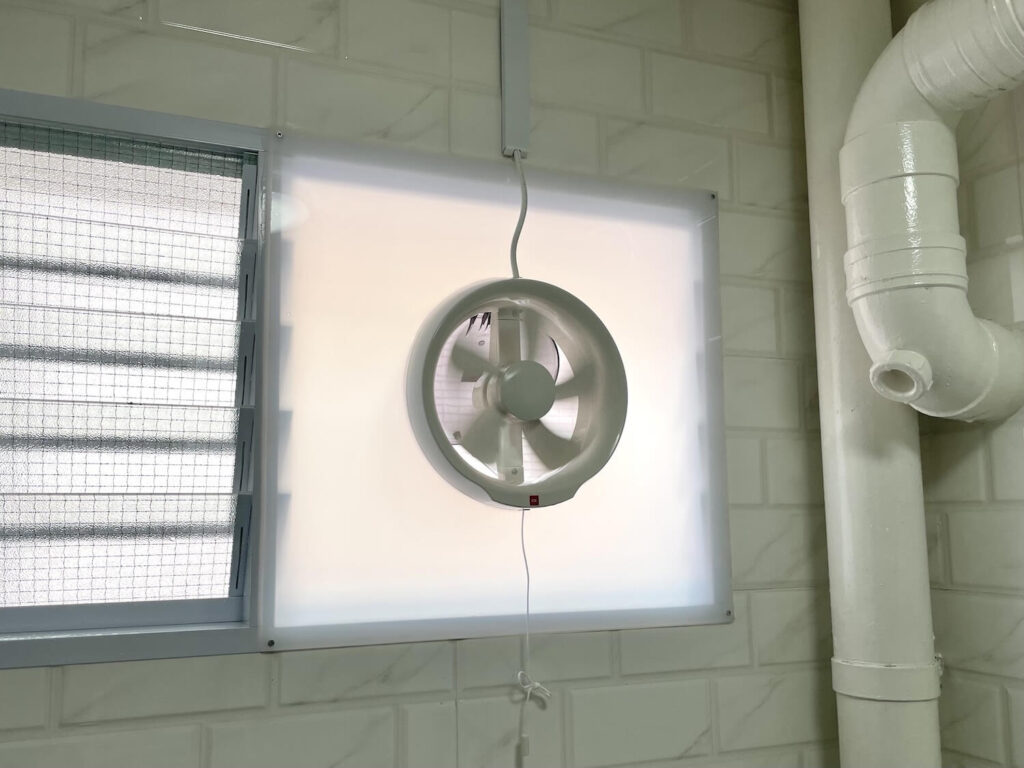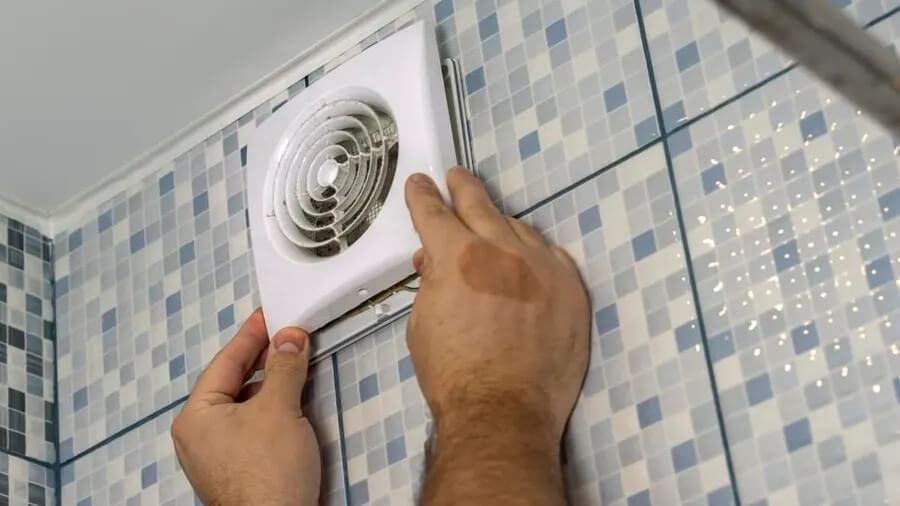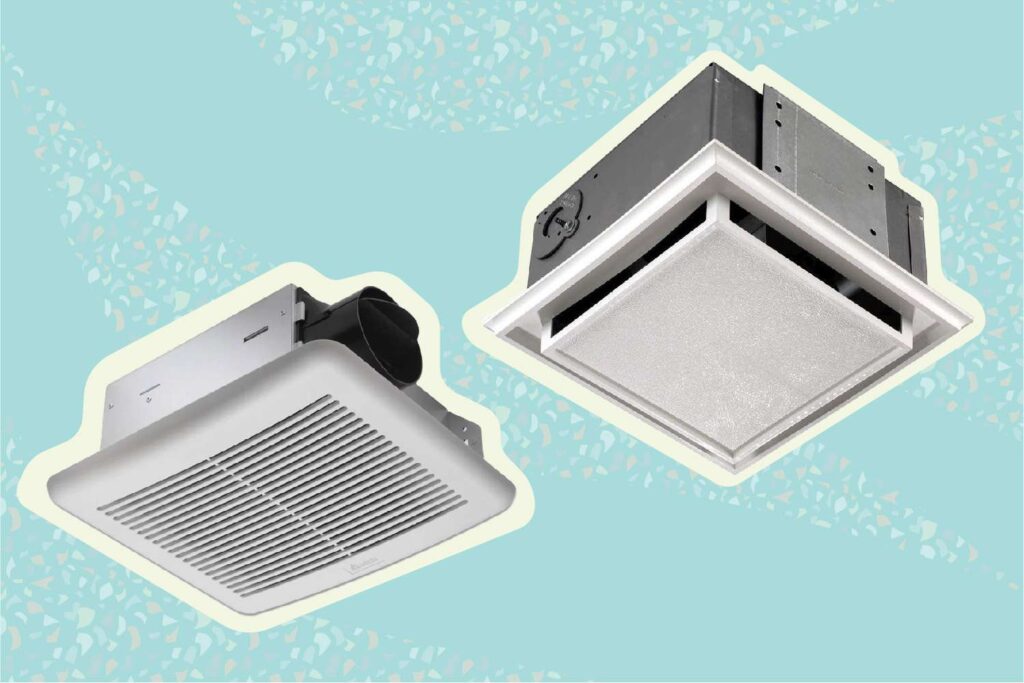So, you’re kickin’ back in your haven of hygiene – the bathroom. You know, that sacred space where profound thoughts come to life, and the shower becomes your personal think tank. But hold up – what’s that annoying hum or, worse, eerie silence coming from your exhaust fan? Could it be playing hooky when it’s supposed to be working overtime? Fear not, because we’re diving deep into the nitty-gritty of fixing a wonky bathroom exhaust fan.
Importance of a Functional Bathroom Exhaust Fan

Let’s cut to the chase – why should you care about that seemingly innocuous whirring contraption on your ceiling? Well, first and foremost, it’s the unsung hero battling humidity and odors. Picture this: you just aced a hot shower, and instead of being enveloped in a cloud of steam, your exhaust fan should be swooping in for the rescue, whisking away that moisture and preventing the breeding ground for mold and mildew. A malfunctioning fan, my friend, can turn your bathroom into a sauna faster than you can say “humidity havoc.”
But it’s not just about the moisture – it’s also about keeping those funky odors at bay. Nobody wants their bathroom to become a smelly hotspot, especially in the heart of the home. So, if your exhaust fan is throwing in the towel, you’re left with unpleasant fragrances lingering longer than a New York minute.
Signs of a Faulty Bathroom Exhaust Fan
Now, how do you know if your exhaust fan has decided to pull a vanishing act on you? Well, for starters, if it sounds like a jet engine on takeoff or it’s suspiciously quiet when it should be humming along, there’s a red flag waving. Excessive noise or eerie silence – neither bodes well. Then there’s the classic symptom of moisture lingering like an uninvited guest after a party – a surefire sign that your exhaust fan might be on strike.
So, if your bathroom in Brooklyn, New York, feels more like a steam room or an odor haven, it’s time to roll up your sleeves and give that exhaust fan the TLC it deserves.
Purpose of the Guide
Now, you might be thinking, “Why bother? Can’t I just let it be?” Well, you could, but that path leads to a bathroom odyssey you’d rather avoid. This guide is your GPS through the labyrinth of fixing a faulty bathroom exhaust fan. We’ll unravel the mysteries, tackle the quirks, and ensure your bathroom in Brooklyn, New York, stays fresh and breezy – just how you like it. So, buckle up, because we’re about to embark on a journey to fan-tastic fixes!
Safety Precautions
Now, before we plunge headfirst into the abyss of exhaust fan troubleshooting, let’s talk safety. It’s like putting on a seatbelt before a rollercoaster – non-negotiable. We want you to come out of this with a functioning fan and all your fingers intact.
Power Off Procedures
First things first, cut the power. It’s not a disco – we don’t need sparks flying. Locate your circuit breaker, do the electric slide, and flip that switch. Confirm the power’s really out by testing the fan switch. Safety begins with ensuring the electrons are taking a break.
Personal Protective Equipment (PPE)
Next up, gear up. This isn’t a fashion show; it’s about shielding yourself. Dust masks, safety goggles – consider them your bathroom DIY armor. Ventilation might be on pause, but safety isn’t.
Ventilation and Air Quality
Ah, the irony – fixing an exhaust fan and forgetting about air quality. Crack open a window or door. We’re messing with dust, possibly mold – let’s not turn the bathroom into a hazard zone. The goal is a breath of fresh air, not a lungful of regret.
Tools and Materials

So, you’ve got your safety dance moves down – what’s next? The right tools and materials, of course. It’s like baking – you can’t whip up a cake without a whisk and some flour. Here’s your bathroom fan repair toolkit:
List of Required Tools:
- Screwdriver Set: For fan cover removal and disassembly.
- Voltage Tester: To ensure the power is truly off.
- Allen Wrench: In case your fan prefers Allen screws.
- Wire Strippers: For any electrical tinkering that might be necessary.
- Cordless Drill: Because we’re in the 21st century, folks.
Necessary Replacement Parts:
- Replacement Motor: If your current one is sputtering like an old car.
- New Fan Blades: For those worn-out warriors.
- Switches or Control Board: When the brain is acting fuzzy.
Recommended Safety Gear:
- Dust Mask: No one wants a lungful of ancient dust bunnies.
- Safety Goggles: Because eyes are precious.
- Gloves: Protect those hands from unexpected surprises.
Now that we’ve suited up and gathered our tools, it’s time to unravel the mysteries within that exhaust fan. Onward to the fan-front, DIY warrior!
Initial Inspection
Alright, let’s roll up our sleeves and dive into the detective work. Your exhaust fan may be acting coy, but we’re about to expose its secrets through a meticulous initial inspection.
Visual Examination of the Exhaust Fan
Grab your trusty screwdriver, and let’s pop the hood – or in this case, the cover. Check for visible wear and tear, loose screws, or any signs of distress. A bit like diagnosing a patient, but without the white coat drama.
Testing the Fan’s Operation
Now, here comes the moment of truth. Turn that fan switch on. Is it humming like a content bee or screeching like a banshee? Note any peculiar noises, as they often spill the beans on what ails the fan.
Identifying Specific Issues
Listen up for any rattling or grinding – those are clues to where the problem lurks. If it’s as quiet as a library in there, your motor might be snoozing on the job. Condensation or rust could be signaling water woes. By identifying these specifics, you’re like a fan whisperer, decoding its language.
Common Problems and Solutions
With our findings from the initial inspection, let’s unravel the mysteries and conquer the common problems that plague these exhaust fans. Here’s a troubleshooting roadmap to fan rehabilitation:
Noisy Operation
- Loose Mounting:
- Issue: Screws playing hide-and-seek.
- Solution: Tighten those screws with the finesse of a surgeon.
- Damaged Blades:
- Issue: Blades looking more worn than a favorite pair of sneakers.
- Solution: Swap them out for a fresh set.
- Foreign Objects:
- Issue: Unwanted hitchhikers causing a ruckus.
- Solution: Remove debris – your fan isn’t a trash compactor.
Lack of Ventilation
- Clogged Air Ducts:
- Issue: Ducts resembling a traffic jam.
- Solution: Clear the blockage – traffic control for your ventilation system.
- Blocked Grilles:
- Issue: Grilles moonlighting as dust magnets.
- Solution: Clean them up – grime shouldn’t be the life of the party.
- Faulty Motor:
- Issue: Motor protesting with silence.
- Solution: New motor in, old one out – time for an upgrade.
Inconsistent Operation
- Wiring Issues:
- Issue: Wires doing the tango without an invite.
- Solution: Inspect and fix – no electrical dance-offs allowed.
- Malfunctioning Switches:
- Issue: Switches being moody.
- Solution: Swap them for well-behaved ones.
- Control Board Problems
- Issue: Brain fog in the control board.
- Solution: Upgrade or replace – give your fan a smarter brain.
Armed with solutions to these common conundrums, you’re now equipped to navigate the repair journey. Buckle up, DIY enthusiast – it’s time to resurrect that exhaust fan!
Step-by-Step Repair Process

Now that we’ve diagnosed the ailments plaguing your bathroom’s exhaust fan, it’s time to put on our fixer-upper hats and dive into the step-by-step repair process. Grab your toolkit, put on some metaphorical superhero music, and let’s get down to business.
Power Disconnect
- Turning off the Circuit Breaker: Ensure your safety dance isn’t in vain. Head to the circuit breaker and cut off the power supply to your bathroom. No one wants unexpected surprises mid-repair.
- Verifying Power Disconnection: Test the waters – or in this case, the wires. Use a voltage tester to double-check that the power is indeed off. Safety first, always.
Removing the Exhaust Fan Cover
- Screw Removal: Break out the screwdriver and gently remove the screws securing the fan cover. It’s like taking off the fan’s hat to see what’s underneath.
- Proper Handling of the Cover: Don’t yank it off like it owes you money. Handle the cover delicately – we’re here for repair, not destruction.
Assessing the Motor and Blades
- Inspecting for Damage: Get up close and personal with the motor and blades. Any signs of wear, rust, or damage? If so, you’ve found the culprit.
- Lubricating Moving Parts: A squeaky wheel gets the grease. If your motor’s protesting, a bit of lubrication might be the remedy. Add oil where needed, but don’t drown it – moderation is key.
Cleaning and Clearing
- Removing Dust and Debris: Your fan isn’t a vacuum cleaner. Use a soft brush or a vacuum cleaner attachment to clear away the dust bunnies and cobwebs that have made a home in there.
- Clearing Blockages: Check the air ducts and grilles for any obstructions. It’s like giving your fan a clear runway for takeoff.
Wiring Inspection
- Visual Check: Look for any loose, frayed, or damaged wires. If the wiring looks like a spaghetti disaster, it’s time for some order.
- Testing for Continuity: Employ your trusty multimeter to check the continuity of the wires. No continuity, no bueno. Time for a rewiring rendezvous.
Replacing Faulty Parts
- Motor Replacement: Bid farewell to the old, tired motor. Install the new one with the precision of a heart surgeon. Connect wires securely, and voilà – a rejuvenated motor.
- Installing New Blades: Out with the old, in with the new. Attach the fresh blades securely, ensuring they’re balanced for optimal performance.
- Upgrading Switches or Control Board: If your switches or control board are throwing a tantrum, replace them with well-behaved counterparts. It’s the fan’s brain makeover time.
With these meticulous steps, you’ve transformed from a mere mortal to a bathroom exhaust fan whisperer. Your fan will be humming harmoniously in no time, and your bathroom will be back to its fresh and breezy self. Keep that toolkit handy – you never know when another DIY adventure awaits!
Maintenance Tips
Congratulations, DIY champion! You’ve conquered the repair realm and resurrected your bathroom exhaust fan. But, as any seasoned warrior knows, the battle isn’t over – it’s time to establish a fortress of fan fortitude. Here are some maintenance tips to ensure your triumph stands the test of time.
Regular Cleaning Schedule
- Dust Off the Fan Blades: Schedule a monthly rendezvous with your fan blades. A gentle wipe or a vacuum cleaner brush keeps them dust-free and ready for action.
- Grille Gratification: Those grilles are like the bodyguards of ventilation. Wipe them down regularly to prevent dust buildup – it’s a small investment for a big return on air quality.
Lubrication of Moving Parts
- Oil the Motor: Your motor deserves a spa day too. A drop of oil on its moving parts ensures smooth operation. Just a dab – we’re lubricating, not drowning.
- Check for Squeaks: If you start hearing squeaks again, don’t panic. A little lubrication can hush them up. It’s like fan therapy – keep it serene and serene.
Periodic Motor Inspection
- Listen to the Hum: Every now and then, take a moment to listen. Is your fan humming contentedly, or is it giving off distress signals? An early diagnosis prevents major breakdowns.
- Visual Motor Check: Peek under the hood occasionally. If you spot any rust, wear, or tear, address it promptly. A stitch in time saves nine – or in this case, saves you from a major fan fiasco.
Upgrading to Energy-Efficient Models
- Embrace Energy Efficiency: In the ever-evolving world of technology, consider upgrading to an energy-efficient model. It not only saves on your energy bills but also contributes to a greener planet.
- Smart Controls for Smart Living:If you’re feeling tech-savvy, explore smart controls. Set timers, control it remotely – the future is now. It’s not just a fan; it’s a smart, savvy companion in your bathroom.
Final Words
And there you have it – the complete guide to resuscitating, maintaining, and future-proofing your bathroom exhaust fan. From unraveling the mysteries of its malfunctions to executing a flawless repair operation, you’re now the master of fan-fu. Keep these tips close, and your bathroom will remain a haven of freshness and tranquility. So, pat yourself on the back, DIY maestro, for you’ve turned a potential bathroom debacle into a triumph of handyman prowess. Until the next DIY adventure calls, keep the air circulating and the fan spinning!
FAQs (Frequently Asked Questions)
Q1: Why is my bathroom exhaust fan making a loud noise?
A1: The culprit behind the racket might be loose mounting screws, damaged blades, or foreign objects lodged in the fan. Tighten screws, replace worn blades, and clear out any debris to restore peace and quiet.
Q2: How often should I clean my bathroom exhaust fan?
A2: A monthly cleaning routine is ideal. Dust off the fan blades, wipe down the grilles, and ensure the entire system is free from debris. Regular maintenance prevents dust buildup and keeps the fan operating efficiently.
Q3: Can I use any type of oil to lubricate the motor?
A3: It’s best to use a light machine oil or specifically designed lubricant for motors. Avoid using excessive amounts – a few drops on the moving parts are sufficient to keep the motor running smoothly.
Q4: Is upgrading to an energy-efficient exhaust fan worth it?
A4: Absolutely! Energy-efficient models not only reduce your electricity bills but also contribute to a more sustainable environment. They often come with advanced features and improved performance, making the upgrade a smart investment.
Q5: How do I know if my bathroom exhaust fan needs a motor replacement?
A5: Listen for unusual sounds, such as grinding or prolonged humming, and visually inspect the motor for rust or visible damage. If the fan struggles to start or exhibits erratic behavior, it’s a sign that a motor replacement might be necessary.
Q6: Can I install a smart control system for my existing bathroom exhaust fan?
A6: In some cases, yes. There are aftermarket smart control options available that can be retrofitted to existing exhaust fans. However, compatibility may vary, so it’s essential to check with the manufacturer or seek professional advice.
Q7: What safety precautions should I take when repairing my bathroom exhaust fan?
A7: Always turn off the power at the circuit breaker, use personal protective equipment (PPE) such as gloves and safety goggles, and ensure proper ventilation to maintain air quality. Following these precautions minimizes the risk of electrical accidents and enhances your safety during the repair process.
Q8: How can I prevent my bathroom exhaust fan from developing issues in the future?
A8: Regular maintenance is key. Clean the fan components, lubricate moving parts, and periodically inspect for any signs of wear or damage. Additionally, consider upgrading to energy-efficient models and embrace smart controls for enhanced longevity and performance.


